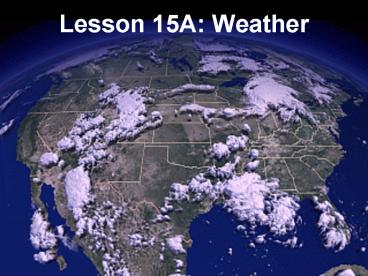Lesson 15A: Weather PowerPoint PPT Presentation
Title: Lesson 15A: Weather
1
Lesson 15A Weather
2
Lesson 21 Weather
- AGENDA
- Causes of Weather
- Weather Elements
- Basic Weather Phenomena (Fronts, Systems)
- Hurricanes/Typhoons
- Marine Weather Prediction
- Applicable reading Hobbs WB, App A
3
Overview
- Weather the state of the Earths atmosphere
- SPECIFICALLY
- Air Flow The circulation of air about the
planet caused by temperature differentials. - Pressure Areas The relationship between
temperature and pressure and wind. - Fronts The transition zone or interface between
two air masses of different densities.
4
Weather Elements
TEMPERATURE
PRESSURE
WINDS
HUMIDITY
CLOUDS
PRECIPITATION
5
Temperature
- Temperature the amount heat in the atmosphere.
- Causes
- The Earths daily rotation about its axis
- The Earths annual revolution about the sun
- Effects
- The uneven heating and cooling of the Earths
surface results in air flow about the planet.
6
Wind
- Wind The horizontal movement of the atmosphere
- Causes
- Temperature differentials
- Coriolis Effect
- Maritime significance
- Result in areas of High and Low pressure.
7
Air Flow
- Forces that define air flow
- 1. Pressure
- 2. Earths Rotation
- 3. Friction from the surface of the earth
8
(No Transcript)
9
Pressure
- Atmospheric Pressure The weight of the
atmosphere. - Causes
- Divergence and convergence of air
- Changes in Altitude/Depth
- Maritime significance
- High/Low pressure systems
- Low (L) - caused by converging winds rotate
counter-clockwise - High (H) - caused by diverging winds rotate
clockwise
10
Low Pressure System Air Flow
11
High Pressure System Air Flow
12
(No Transcript)
13
Weather Fronts
- High and Low pressure systems travel from the
areas where they are created. - When air masses meet, they compete for
dominance. - The boundary zone between these two masses is
known as a front.
14
Weather Fronts
- Fronts a zone of transition between air masses
- Cold Front - when a cold air mass displaces a
warm air mass by vigorously forcing it up. - move fast, 20-35 kts
- weather deteriorates rapidly
- Warm Front - when a warm air mass displaces a
cold air mass. - warm air slides over cold air
- move slowly, 19-15 kts
- weather deteriorates gradually
15
Frontal Passage
16
(No Transcript)
17
Basic Weather Phenomena
- Clouds
- Fog
- Tropical storms/hurricanes/typhoons
18
Heavy Weather
1. Closed Cyclonic - Rotary circulation
storms. 2. Noncyclonic - Storms produced by
prevailing winds are identified by their
accompanying winds - predictable.
19
Closed Cyclonic
1. Tornadoes - Violent, whirling storm of small
diameter that travels across land. Appear as
funnel shaped cloud, with a vortex that may or
may not touch the earth. Winds blow spirally
upwards from 150 - 300 mph. 2. Waterspouts -
Similar to tornadoes, occurring over oceans or
inland waters. Usually less destructive than
tornadoes.
20
Closed Cyclonic
3. Squall - A wind of considerable intensity
caused by atmospheric instability. Comes up
dies quickly, sometimes accompanied by thunder,
lightning and precipitation. 4. Monsoons -
Steady winds somewhat similar to trade winds.
Can reach moderate gale proportions and are
accompanied by heavy squalls and thunderstorms
during the summer.
21
Closed Cyclonic
5. Hurricanes - Tropical storm with continuous
winds greater than 75 mph (64 kts). 6.
Tropical Storms - Categorized based on wind
speed
- Tropical Depression lt 34 kts
- Tropical Storm 34 - 63 kts
- Hurricane gt 63 kts
22
Noncyclonic
ie gale - with winds from 34 - 47 mph
storm - with winds of 48 mph or greater.
23
(No Transcript)
24
Weather Elements(Review)
TEMPERATURE
PRESSURE
WINDS
HUMIDITY
CLOUDS
PRECIPITATION
25
Clouds
- Clouds condensed water droplets or ice
crystals suspended over the
surface of the earth - Causes of clouds
- Clouds are formed by the cooling of saturated air
by the ocean of land surface beneath. - Basic Types of Clouds
- Cirrus
- Cumulus
- Stratus
26
(No Transcript)
27
(No Transcript)
28
(No Transcript)
29
Coastal Fog
- Fog a cloud that touches the surface of the
earth. - Causes of clouds/fog
- Clouds are formed by the cooling of saturated air
by the ocean of land surface beneath. - Prediction of fog
- If the difference between air temperature and dew
point is less than 2F, fog may result.
30
Hurricanes/Typhoons
- Hurricanes violent storms with no associated
weather front. - Causes
- Storms begin in a low-pressure area, lifting of
the air, and a counter-clockwise inward wind
flow. - Heat released by condensation of water vapor
from the surface below aggravates the process and
the storm builds in intensity.
31
(No Transcript)
32
Review/Summary
- What 3 elements cause weather?
- Name 4 of the 6 basic weather elements
- What is a front?
- Describe the following types of clouds
- Cirrus
- Stratus
- Cumulus
33
Questions?

